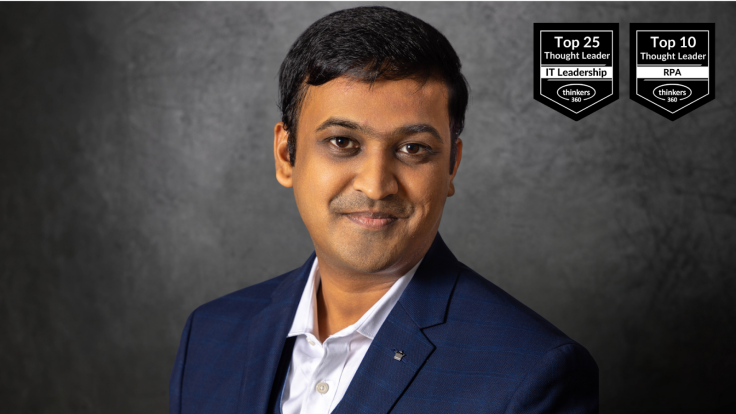Santhosh Vijayabaskar Pioneers Scalable Automation For Financial Institutions With AI And RPA
By leveraging automation and artificial intelligence (AI), Vijayabaskar has created a blueprint for the industry's future

Financial institutions must process trillions of dollars in global markets daily through modernised operations. Traditional financial systems buckle under the weight of transaction volumes, regulatory requirements, and customer demands. The sheer scale of modern financial operations requires immediate action, with institutions handling millions of transactions across multiple time zones and jurisdictions.
Among the leaders driving this transformation is Santhosh Vijayabaskar, an innovator in robotic process automation (RPA) and intelligent automation who is pioneering sophisticated solutions that are setting new benchmarks for operational efficiency in financial services. By leveraging automation and artificial intelligence (AI), Santhosh Vijayabaskar has created a blueprint for the industry's future, where automated systems manage high transaction volumes with unparalleled speed, precision, and regulatory adherence.
Meeting the New Demands of Financial Operations
The demands on financial institutions have escalated post-COVID, with the U.S. brokerage market alone achieving an estimated revenue of $196.99 billion by the third quarter of 2024, projected to grow to $242.33 billion by 2029. As automation proves essential in handling such volume, the need for intelligent, scalable automation solutions is more pressing than ever. Financial institutions now operate robust systems that merge robotic process automation with artificial intelligence to handle complex operations efficiently.

Santhosh Vijayabaskar, Director of automation and process re-engineering, directs this advancement by automating several hundred mission-critical processes, such as wire reconciliation, transaction validation, share transfer processes, and regulatory reporting, all of which address current operational needs and future growth requirements. This automation has led to reductions in processing time and error rates, underscoring the tangible benefits of advanced automation.
"Transaction volumes and complexity overwhelm traditional operational models," states Santhosh. "Our automated systems execute high-volume financial transactions round-the-clock while maintaining stringent regulatory compliance standards. The financial sector demands continuous operation, and our systems deliver measured reliability and accuracy."
Building a Scalable, Human-Centric Automation Framework
As a visionary in financial automation, Santhosh advocates a comprehensive, multi-layered polyglot architecture. By combining low-code platforms, task-based robotic process automation (RPA), and business process management (BPM) as the central orchestrating layer, he has created a system that is both flexible and robust—perfectly aligned with the complex demands of modern finance.
At the heart of Santhosh's strategy is Human-in-the-Loop (HITL) automation, an essential feature that enables human expertise to enhance automated processes. Recognising that certain high-stakes tasks require skilled oversight, he has embedded HITL within a low-code framework, allowing professionals to step in precisely when needed. This fusion of automation and human insight brings a level of precision and reliability that pure automation alone cannot achieve, reinforcing the accuracy of every financial workflow.
Santhosh's RPA implementation targets high-frequency, rule-based tasks, reducing manual workloads and minimising error rates across operations. Importantly, this RPA solution doesn't function in isolation—it's part of a larger, interconnected ecosystem that drives efficiency throughout the organisation. As the orchestrator, BPM technology unifies these automated tasks into a cohesive, efficient workflow. This layered, interwoven system exemplifies Santhosh's forward-thinking approach: each component fulfils an immediate operational need while remaining scalable to meet future demands.
"Automation in finance is about building something more than efficient systems," Santhosh explains. "We're designing adaptable solutions where every layer—whether it's HITL, RPA, or BPM—works in harmony to achieve the highest standards of precision and resilience."
With this technology stack, Santhosh is setting a new industry benchmark.
His vision offers financial institutions a blueprint for embracing automation that not only meets current demands but also lays a foundation for sustainable growth in an increasingly digital landscape.
"Financial operations require exact execution in automation," he emphasises. "Human aptitude paired with artificial intelligence creates precise financial operations, elevating operational efficiency and strengthening risk management."
Laying the Data Foundation for Scalable Automation
As financial institutions embrace automation at scale, Santhosh emphasises a critical prerequisite: establishing a strong foundation of data standardisation and governance. In an industry where high-volume trade transactions and regulatory compliance are paramount, Santhosh's approach treats data as the bedrock of every successful automation initiative.
Santhosh advocates for a comprehensive approach to data standardisation to streamline processes like transaction validation and regulatory reporting. By ensuring that data remains uniform and accessible across the entire automation stack, he leverages advanced concepts like data lineage and data fabric architecture to maintain accuracy and transparency throughout complex workflows.
Data lineage gives financial institutions the ability to trace every piece of data back to its origin, tracking how it changes across systems—a vital capability for meeting regulatory standards and reducing errors. Meanwhile, data fabric architecture connects data from various sources, whether stored on-site or in the cloud, into one unified, easily accessible layer, which can improve data retrieval efficiency by up to 40%.
"Reliable data is at the core of effective automation," Santhosh notes. "Without standardisation, even the most sophisticated automation systems risk inefficiency and breakdowns." Through these technologies, he positions institutions to keep data consistent and accessible, minimising disruptions and accelerating transaction processing in today's fast-moving financial landscape.
Equally important in his approach is data governance—setting robust policies around data quality, access, and compliance. By establishing clear standards and controls, financial institutions can maintain integrity and security across high-stakes processes, from trade execution to regulatory reporting. This governance framework not only enhances risk management but also enables institutions to meet evolving data regulations with confidence.
Data preparation is another key aspect of Santhosh's strategy, where meticulous data cleaning, integration, and enrichment create a seamless flow across automated workflows. By ensuring that data is well-prepared, institutions can scale automation without compromising on accuracy or compliance, ultimately positioning themselves for resilient, data-driven growth in an increasingly digital financial sector.
Through this data-centric approach, Santhosh sets a new benchmark for financial automation, allowing institutions to harness the full potential of automation while laying a sustainable foundation for future innovation.
The Road Ahead: Shaping the Future of Financial Automation
As automation continues to reshape the financial sector, Santhosh Vijayabaskar's strategic innovations in RPA, data standardisation, and governance are setting new standards for reliability and efficiency.
"In an era where data and speed define success, automation isn't just a tool—it's a strategic advantage," Santhosh adds, noting that institutions adopting intelligent automation are positioning themselves to lead in today's complex and competitive market.
Santhosh's work not only addresses the pressing needs of today but also builds a resilient, scalable foundation for a rapidly evolving digital landscape. Through his visionary leadership, he is helping to forge a future where data-driven growth, adaptability, and operational excellence define success in financial automation.
© Copyright IBTimes 2025. All rights reserved.





















